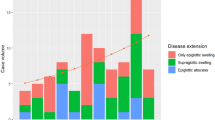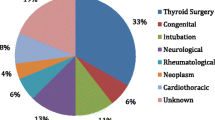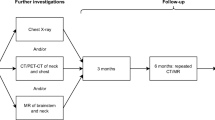Abstract
Purpose
Acute supraglottic laryngitis (ASL) is manifested by supraglottic inflammation that has the potential for rapid and fatal airway obstruction. Complete/incomplete vocal fold immobility (VFIm) in the setting of ASL may contribute to airway obstruction. The rate of VFIm complicating ASL is not known, and it is not clear whether its occurrence alters the course and the management of ASL, particularly the need to secure the airway (by endotracheal intubation/tracheostomy). This study seeks to describe the natural history of VFIm associated with ASL (ASLIm) and to determine the added effect of VFIm on ASL severity, management, and the need for intervention to secure the airway.
Methods
This is a retrospective cohort study in a tertiary referral center. The medical records of all patients hospitalized due to ASL between January 2007 and December 2016 were reviewed.
Results
Of the 214 patients admitted due to ASL, VFIm was identified in 9 (4.2%). The VFIms resolved within 1–90 days in all 8 patients with available follow-up of 1–3 months. One patient required endotracheal intubation. The 9 ASLIm patients had significantly higher rates of hoarseness and a history of diabetes mellitus. There was no group difference in the need to secure the airway.
Conclusions
VFIm is an apparently uncommon finding among patients with ASL. It appears to be usually transient, short-lasting, and full recovery can be expected. VFIm did not alter the ASL course, nor did it put our patients at increased risk for the need for intervention to secure the airway.
Level of evidence
4.

Similar content being viewed by others
References
Wolf M, Strauss B, Kronenberg J, Leventon G (1990) Conservative management of adult epiglottitis. Laryngoscope 100:183–185
Wong EYH, Berkowitz RG (2001) Acute epiglottitis in adults: the Royal Melbourne Hospital experience. ANZ J Surg 71:740–743. https://doi.org/10.1046/j.1445-1433.2001.02265.x
Berger G, Landau T, Berger S, Finkelstein Y, Bernheim J, Ophir D (2003) The rising incidence of adult acute epiglottitis and epiglottic abscess. Am J Otolaryngol 24:374–383. https://doi.org/10.1016/S0196-0709(03)00083-8
Shah RK, Stocks C (2009) Epiglottitis in the United States: national trends, variances, prognosis, and management. Laryngoscope 120:1256–1262. https://doi.org/10.1002/lary.20921
Guardiani E, Bliss M, Harley E (2010) Supraglottitis in the era following widespread immunization against Haemophilus influenzae type B: evolving principles in diagnosis and management. Laryngoscope 120:2183–2188. https://doi.org/10.1002/lary.21083
Ng HL, Sin LM, Li MF, Que TL, Anandaciva S (2008) Acute epiglottitis in adults: a retrospective review of 106 patients in Hong Kong. Emerg Med J 25:253–255. https://doi.org/10.1136/emj.2007.050153
Briem B, Thorvardsson O, Petersen H (2009) Acute epiglottitis in Iceland 1983-2005. Auris Nasus Larynx 36:46–52. https://doi.org/10.1016/j.anl.2008.03.012
Park HH, Lee JC, Lee TH, Kwon JK, Nam JK (2012) Acute supraglottitis in adults: what’s the optimal airway intervention? Auris Nasus Larynx 39:204–207. https://doi.org/10.1016/j.anl.2011.08.005
Madhotra D, Fenton JE, Maura ZGG, Charters P, Roland NJ (2004) Airway intervention in adult supraglottitis. Ir J Med Sci 173:197–199. https://doi.org/10.1007/BF02914550
Chroboczek T, Cour M, Hernu R et al (2015) Long-term outcome of critically ill adult patients with acute epiglottitis. PLoS One 10:4–11. https://doi.org/10.1371/journal.pone.0125736
Shah RK, Roberson DW, Jones DT (2004) Type B vaccine era: changing trends. Laryngoscope 114:557–560
Ovnat Tamir S, Marom T, Barbalat I, Spevak S, Goldfarb A, Roth Y (2015) Adult supraglottitis: changing trends. Eur Arch Otorhinolaryngol 272:929–935. https://doi.org/10.1007/s00405-014-3464-x
Katori H, Tsukuda M (2005) Acute epiglottitis: analysis of factors associated with airway intervention. J Laryngol Otol 119:967–972. https://doi.org/10.1258/002221505775010823
Shapira Galitz Y, Shoffel-Havakuk H, Cohen O, Halperin D, Lahav Y (2017) Adult acute supraglottitis: analysis of 358 patients for predictors of airway intervention. Laryngoscope 127:2106–2112. https://doi.org/10.1002/lary.26609
Acknowledgements
Esther Eshkol, MA, the institutional medical and scientific copyeditor (Tel-Aviv Sourasky Medical Center) is thanked for editorial assistance. Tomer Ziv, PhD, is thanked for statistical analysis.
Funding
The authors have no funding, financial relationships, or conflicts of interest to disclose.
Author information
Authors and Affiliations
Corresponding author
Additional information
Publisher's Note
Springer Nature remains neutral with regard to jurisdictional claims in published maps and institutional affiliations.
Rights and permissions
About this article
Cite this article
Ringel, B., Horowitz, G., Shilo, S. et al. Acute supraglottic laryngitis complicated by vocal fold immobility: prognosis and management. Eur Arch Otorhinolaryngol 276, 2507–2512 (2019). https://doi.org/10.1007/s00405-019-05508-3
Received:
Accepted:
Published:
Issue Date:
DOI: https://doi.org/10.1007/s00405-019-05508-3




